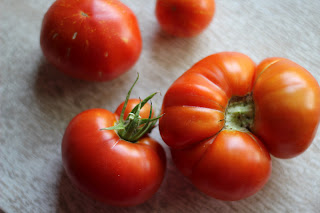This time of year, many are inundated with an overflow of garden-fresh tomatoes.
Think of it as a good thing.
The good news is that they're like money in the bank.
You don't have to do too much to or with them and they can add a lot to a meal.
What to do with them?
First, do not refrigerate them, they'll lose their intense tomato flavor and the texture can become mealy.
That would be the reason tomatoes fresh from the garden taste better than those from the grocery store- the tomatoes from the store were most likely refrigerated to keep them from going bad since they probably travelled a distance to get to you.
Tomatoes should be stored at room temperature, not stacked up, not packed in.
They're delicate, give them some space. Air will circulate better, you've left a little less chance for rot, and if they're not stacked they won't be smashed so easily.
Tomatoes are crucial components in many recipes.
Of course, they're at their best when raw, fresh from the vine and warmed by the sun (especially when they don't have a future in the oven or a frying pan). They're sweeter, more tomato-y.
Even if the looks or the color isn't completely magazine perfect, they still taste better.
In fact, I think they taste best when they don't look perfect.
Fighting the elements must do them good.
Heirloom varieties offer different flavors and textures as well as colors and patterns.
And the flavor hasn't been engineered out of them in favor of perfectly circular tennis ball-sized orbs with a just so shade of tomato red and a satiny sheen.
Frequently, things that grow together, go together.
Another way of putting it would be that things that are stereotypical to a certain location or style of food are pretty much that way for a reason.
Tomatoes/basil/Italy.
However, as ubiquitous as tomatoes may be when we think of Italy, they're not really Italian. Like potatoes and corn, they're an originally imported New World crop.
The good news is that they can go with just about everything, and though normally used as a vegetable, they can become switch hitters and work for the fruit team (to which they really belong anyway).
The strict tomato/vegetable issue must be a mindset thing.
But think about it: what do tomatoes add to a dish?
Sweetness and acidity, which seem like very fruity things to do.
So, what to do with tomatoes?
Sweet and easy to handle, garden-ripened cherry, grape, and pear tomatoes are wonderful left out in a bowl, ready for snacking.
If I use fresh tomatoes, I prefer to use a variety all at once, and I like to cut them differently, too.
The larger ones sliced into rounds, the medium ones quartered or cut into sixths, smaller ones halved or left whole. This way, the tomatoes are more visually appealing with their shapes and textures as well as color and personality (well, as far as tomato variety goes).
There is more involved in eating than just the sense of taste.
Here's a little list to get things started:
Sauces, whether cooked or fresh
Tossed fresh into hot pasta
Soup, such as gazpacho or roasted tomato
Salsa
Tomato salad
Caprese salad
Compote, confit
Roasted
Sauteed
Eaten out of hand
Added to quinoa
On pizza
Tomato tart
In sandwiches
As a relish
Drizzled with olive oil, sprinkled with salt and pepper
Cored and stuffed with tuna salad, chicken salad
Smaller tomatoes stuffed with chevre and fresh herbs
Perhaps an internet search for any of these ideas or including several on-hand ingredients might be helpful if brainstorming isn't fruitful...















great ideas,
ReplyDeletebeautiful pictures,
lovely summer post,
and refreshing
for the worn out gardeners.